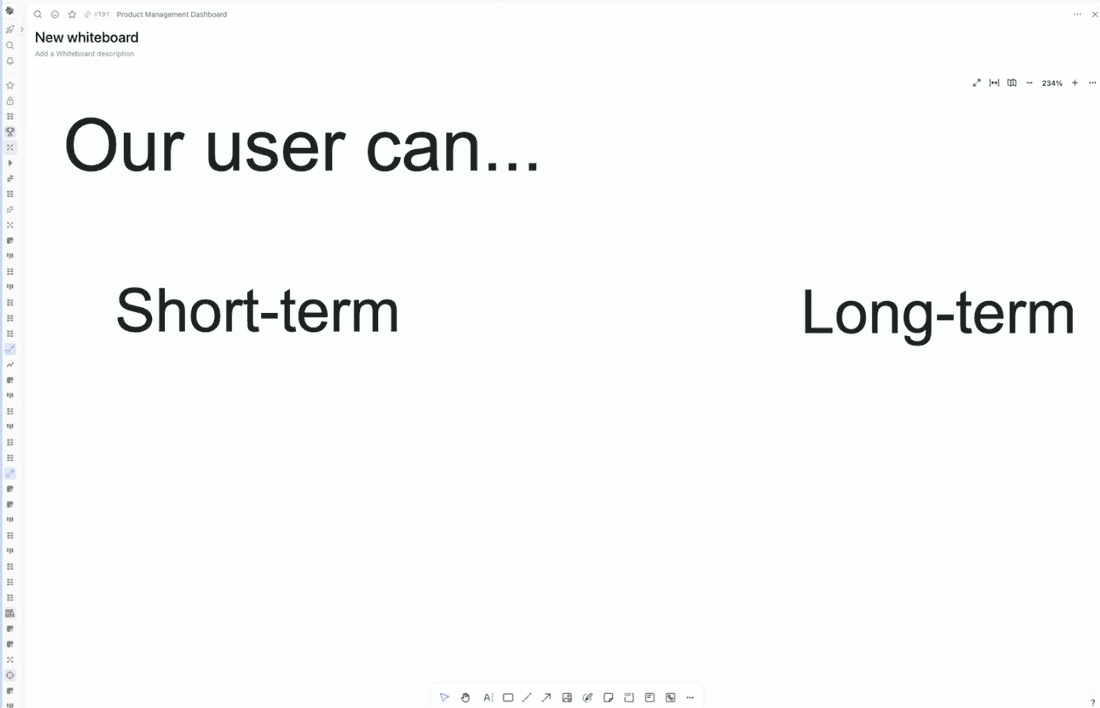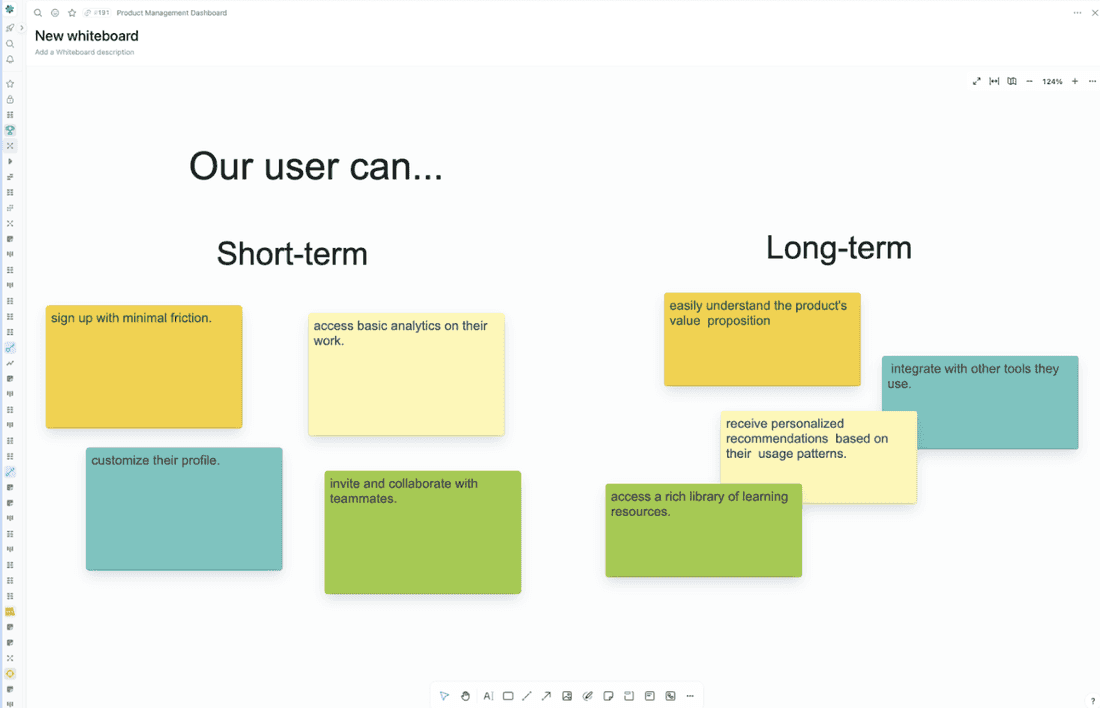What are Experience-Based Roadmaps? Definition and Examples
Roadmaps that only list feature updates are… a bit boring, don’t you think? It’s time to focus on what matters most – the user! An experience-based roadmap is your key to crafting exceptional customer journeys. It charts the ideal experiences you want people to have with your product or service.
In this article, we’ll break down:
- What experience-based roadmaps are and why they stand out
- The pros and cons of adopting this framework
- A detailed guide on how to create your own
What is an experience-based roadmap?
An experience-based roadmap is a strategic plan that focuses on crafting the ideal customer or user journey with your product or service. It outlines the desired experiences you want to provide across all touchpoints, prioritizing how those experiences improve the lives of your customers.
Here’s why it’s different from a traditional roadmap:
- Focus on Outcomes: Instead of a list of features or releases, it emphasizes the experiences you want users to have.
- Holistic Vision: It takes a wider view, going beyond the product itself to include things like support, marketing, and the entire customer lifecycle.
- User-Centric: The user’s needs, perspectives, and emotions are at the heart of this type of roadmap.
What are the pros and cons of having an experience-based roadmap?
Here’s a breakdown of the pros and cons of using an experience-based roadmap:
Pros of experience roadmap
- Strong Focus on the User: Experience-based roadmaps put the user experience at the center. This ensures teams create products and services that genuinely solve customer pain points and provide value.
- Improved Collaboration: By outlining the desired customer journey, experience-based roadmaps break down silos between departments. It helps teams across product, marketing, and customer support align their efforts.
- Prioritizes Outcomes: This type of roadmap moves away from a feature-driven mentality. It instead emphasizes the end results and experiences you want to deliver for your customers.
Cons of experience roadmap
- Can Lack Specificity: Experience-based roadmaps tend to be high-level. Translating these broad goals into specific features or development tasks can sometimes be a challenge.
- Requires Change Management: Teams used to traditional, feature-focused roadmaps may need time to adjust their thinking. Shifting towards an emphasis on user experience can require a change in mindset.
- Difficulty Measuring Success: Since experience-based roadmaps focus on qualitative outcomes (like customer satisfaction or delight), they can be harder to measure than traditional roadmaps that track feature releases or deadlines. Teams will need to establish clear metrics and KPIs that accurately reflect progress toward the desired customer experiences.
Experience-based roadmaps offer powerful advantages for companies that want to become truly customer-centric. But they may need to be supplemented with more detailed tactical roadmaps to ensure smooth execution.
How should you create an experience-based roadmap?
You can build a roadmap in two ways:
- Using traditional pen and paper
- Using visual collaboration tools
We happen to know a perfect tool for visual collaboration – so we’re going to use it throughout this tutorial.
Building your roadmap
Once you’re set up with the right tools, write the statement “Our user can/our user will be able to…” on the top of your writing surface:

Add two labels right below the statement:
- “Short-term” on the left
- “Long-term” on the right

To illustrate the user enablements of your solution, use sticky notes to complete sentences like “Our user can…” or “Our user will be able to…” Here are some examples:
- Our user can… modify their profile information.
- Our user will be able to… easily sign up for a free trial.

Pro tip: If you don’t like wasting paper during brainstorming, you might use Fibery’s whiteboard feature with sticky notes that don’t hurt trees.
After generating a sufficient number of ideas on the grid, the team can begin to reorganize them based on their relative importance and feasibility.
Some ideas may require immediate implementation, while others can be deferred to a later release.
To clarify which features to prioritize, spread them all across a rough timeline divided into three stages.
Each stage expresses your teams certainty about developing each user experience:
- Stage 1: Experiences you’re sure to build in the near future
- Stage 2: Experiences you think you will build.
- Stage 3: Experiences you might build in some time.
As you might’ve noticed, the stages divide not specific features, but overall experiences for the user. This is why this type of roadmap is called the “experience” roadmap.
A well-organized experience-based roadmap will look like this:
- Stage 1: Focus on the core onboarding experience.
- Our user can… sign up with minimal friction.
- Our user can… easily understand the product’s value proposition.
- Our user can… complete a quick tutorial demonstrating essential features.
- Stage 2: Introduce features that enhance the core experience.
- Our user can… customize their profile.
- Our user can… invite and collaborate with teammates.
- Our user can… access basic analytics on their work.
- Stage 3: Add advanced functionality and “delight” features.
- Our user can… integrate with other tools they use.
- Our user can… receive personalized recommendations based on their usage patterns.
- Our user can… access a rich library of learning resources.
You’ve got the basic roadmap all done. Time to spice things up a bit with some extra information you can squeeze out from implementing this system in your team.
Document your learnings
Add a row under each stage where you’ll document what you will learn from each stage.
Here’s what would go into the roadmap based on our previous example:
- Stage 1:
- How quickly can users complete the signup process?
- What percentage of users engage with the tutorial?
- What are the first tasks users try to accomplish, and how successful are they?
- Stage 2:
- Do users find the customization options valuable?
- What’s the adoption rate of collaboration features?
- How does basic analytics usage impact user understanding of their results?
- Stage 3:
- Which integrations are most in-demand?
- Does the personalized recommendations feature improve engagement?
- Do users actively utilize the learning resources provided?
Adding a “What we’ll learn” row under each stage:
- Emphasizes Iteration: Reminds teams that experience roadmaps are about continuous learning, not just shipping features.
- Drives Data-Driven Decisions: Identifies specific questions you’ll seek to answer, guiding data collection and analysis during each stage.
- Aligns Teams: Ensures development, product, and marketing teams are all working towards gathering insights that will inform future experience improvements.
Plan playbacks
Aligning your experience-based roadmap to specific deadlines and schedules is a must. To ensure you execute the plans you created, plan a series of playbacks within your roadmap.
This will help you keep a close eye on your progress and communicate each milestone of your project with stakeholders.
The PM’s hot take
Ditch the feature laundry list for an experience-based roadmap. It’s about dazzling user journeys, not just ticking boxes. Though they’re high-level and need a bit of detail to execute, these roadmaps put the spotlight on users, breaking down silos along the way.
Quick guide: Map out now, soon, and later from your users’ perspective, iterate based on feedback, and celebrate milestones. Want to make your product unforgettable? This is how. Grab a tool, plot those experiences, and watch your product shine.
Conclusion
Experience-based roadmaps offer a powerful way to become truly customer-obsessed. If you’re ready to prioritize what your users truly want and need, this is the roadmap style for you – and you can easily create it using Fibery’s Whiteboard.
Psst... Wanna try Fibery? 👀
Infinitely flexible product discovery & development platform.